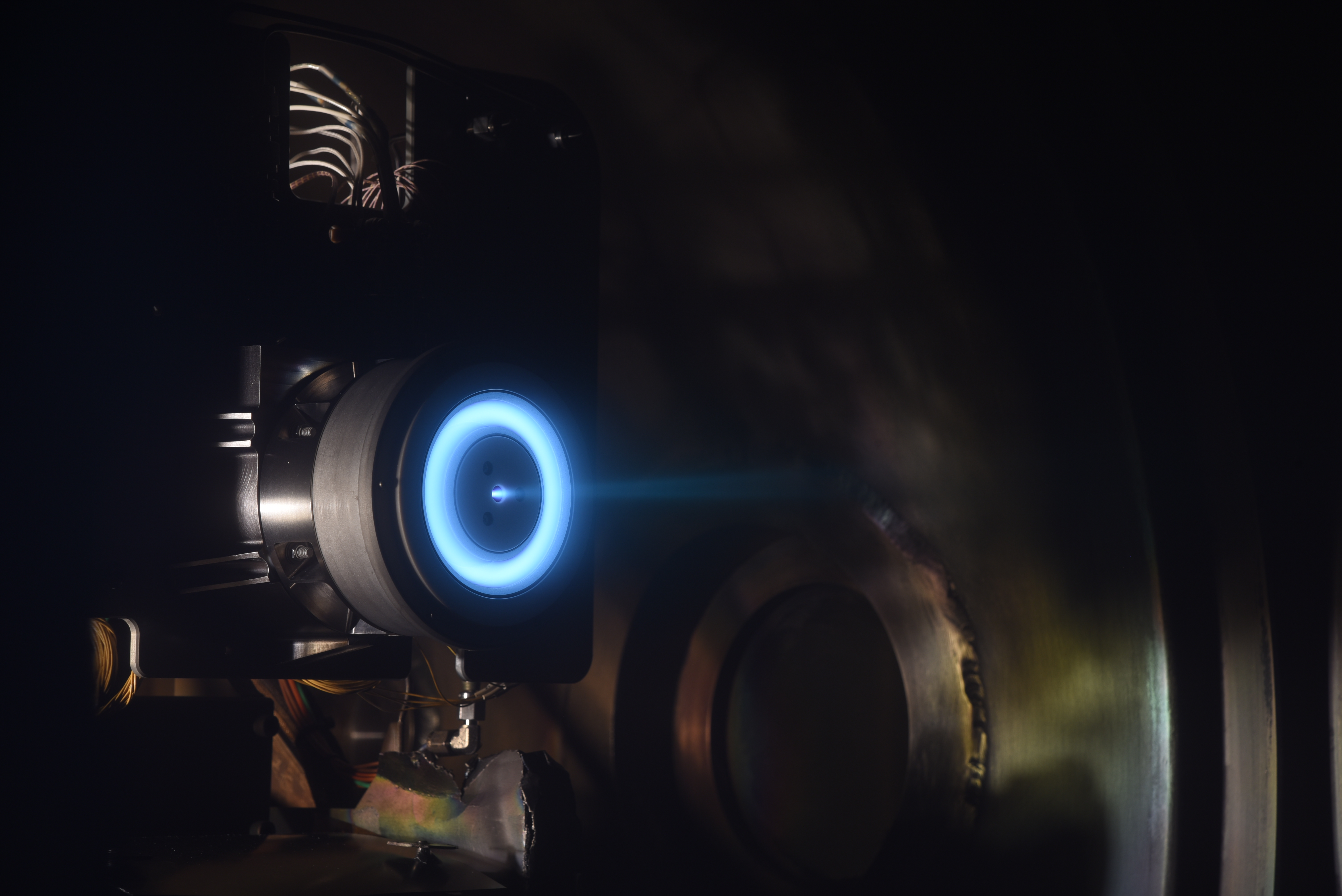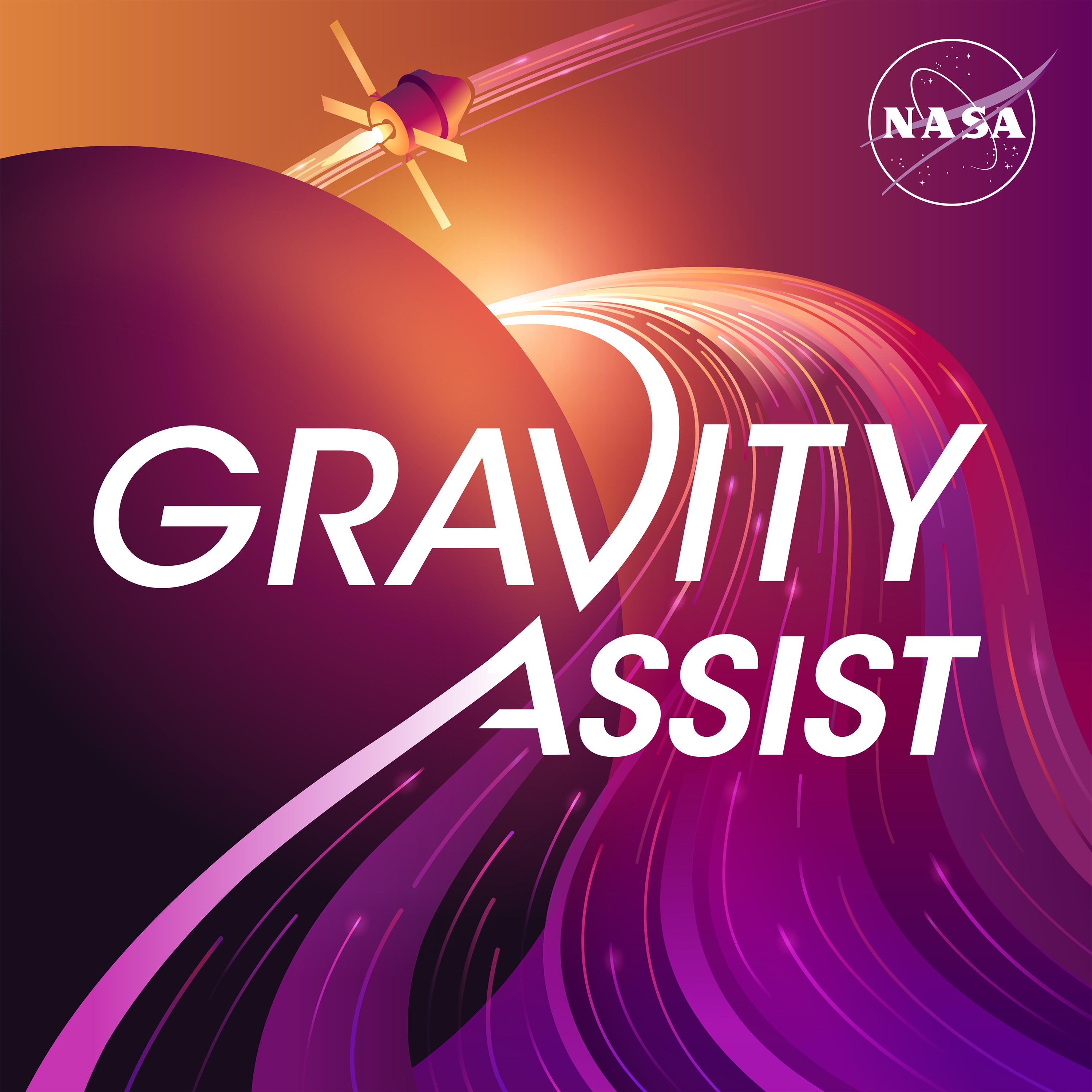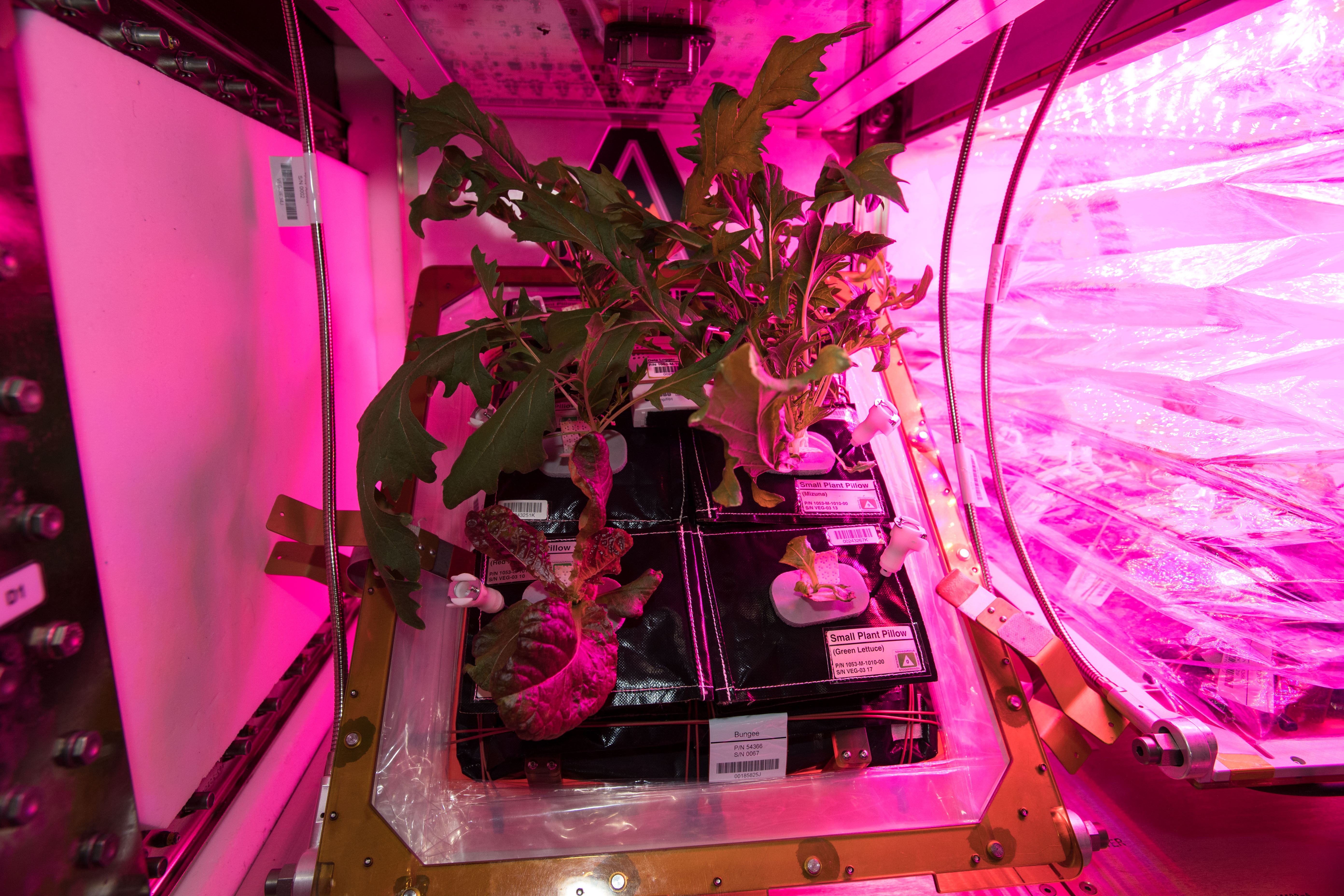
Astronauts on the International Space Station have been conducting experiments to grow food, including peppers and radishes. Christina Johnson, aNASA postdoc fellow at NASA’s Kennedy Space Center in Florida, has been working on a variety of techniques to grow food in space. Learn what she thinks about the future of growing food beyond our planet, including on Mars.
Jim Green:For humans to live, we need food. So how are we going to survive when we begin to live and work in faraway places in space?
Christina Johnson:It’s really fun to see all these leafy greens that we’ve been growing in space for the last few years because the astronauts can eat them right away.
Jim Green:Hi, I’m Jim Green, and this Gravity Assist, NASA’s interplanetary talk show. We’re going to explore the inside workings of NASA and meet fascinating people who make space missions happen.
Jim Green:I’m here with Dr. Christina Johnson. And she is a NASA postdoc fellow at NASA’s Kennedy Space Center in Florida. Christina works on a variety of projects related to growing plants in space. Welcome, Christina, to Gravity Assist.
Christina Johnson:Oh, thank you so much for having me here.
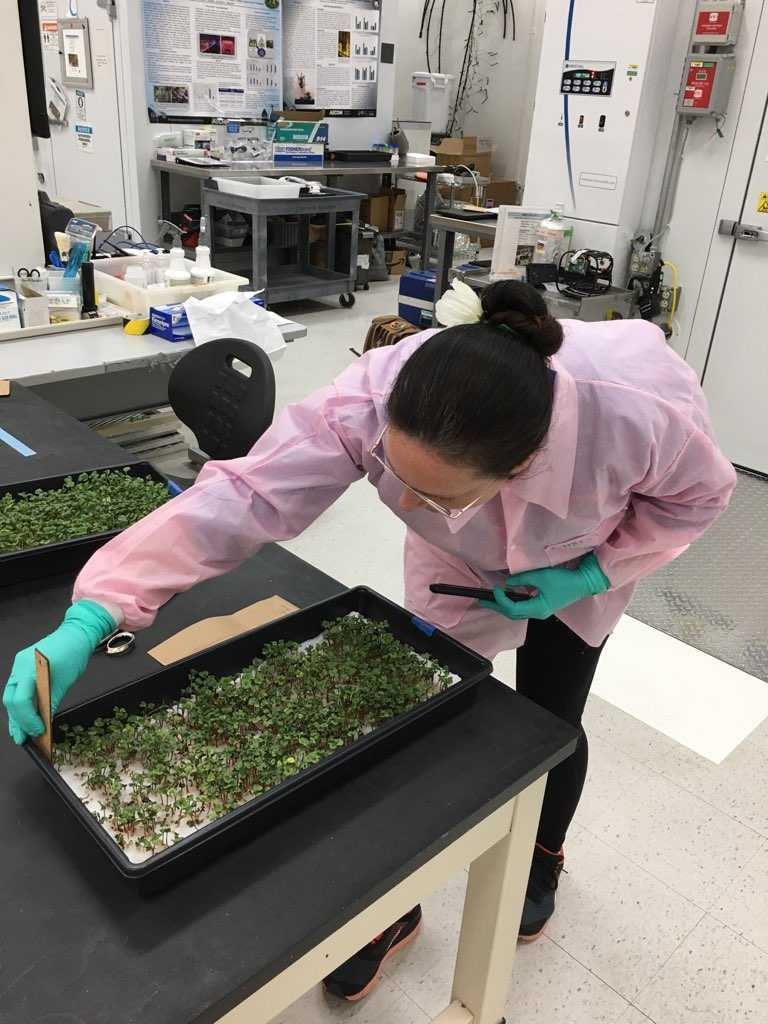
Jim Green:You know, when we think about growing plants in space, what are the kind of challenges that we have to consider? And how do we overcome them?
Christina Johnson: Oh, that’s such a great question. So when we grow plants here on Earth, we have gravity, we have good airflow, we have the sunlight. And when we get into space, we lose a lot of that we, we can’t access the sun because it’s not safe to have that much sunlight in the space occupied by the crew. And so we need to bring in our own lights, we use LED lighting, because it’s very lightweight, and we can bring just the right lights that we want, then we also have to think about airflow. In space, you get pockets of air, you get pockets with high co2 and low co2, and those plants need a more homogenous air source.
Christina Johnson:And so we use fans who bring fans in to move the air around the plants. Another thing that we run into is water. We love water, plants need water. And we need to deliver that water in a way that also delivers a little bit of air and oxygen to those roots. They’ll suffocate without getting a little bit of air along with the water. And you don’t really think about that. Because here on Earth, you have a lot of mixing in the water. And in space, you don’t get that mixing so well, that’s really unique problems,
Jim Green:Yeah, boy, that sounds like a pretty tough challenge to me. So you know, when we take plants up? Or actually what do we do? Do we take the seeds up and grow the seeds? Or do we actually have starter plants? What’s the best way to do that?
Christina Johnson:Oh, that’s a great question. So there are a lot of different ways that we can do this, and a lot of different ways that have been done over the decades that we’ve been growing plants in space. But our favorite way right now is to send up seeds and grow things from seeds.
Jim Green:Wow. That’s, that’s phenomenal. Yeah. So So you know, so it’s not like you got seeds floating around in the cabin, you got some sort of containment? What does that look like? And how do you how do you get the seeds to get going? Is it just from light and water? Or what kind of nutrients do they have to have?
Christina Johnson:So when we bring our seeds up there, they’re stuck between two wicks, or they are stuck on seed films, which are a really great invention that we came up with here at Kennedy Space Center we have this, this film that the seeds are embedded in. And then we can take that film out, again, have it in a filing cabinet basically, and put that in in the hardware when we want to grow them. So that one was a great innovation, then we also have I’ve been playing around with pre-seeding mats, but we haven’t sent those to space yet. Where I have the mats that I’m going to be growing my plants on. The seeds are glued down on that and very stable. And then we could plant them and add water.
Christina Johnson:So the key for getting germination going is adding water. And we can choose to add light at the same time or we can choose to add light a little bit later. And that’s actually something I’m looking at to: At what point do we need to add that light to have really good growth? Do we need to add it right away? Different seeds actually have different requirements some plants really germinate the best when they’re in the dark, and other plants germinate the best when they’re in the light. And so determining which crops we’re going to grow that’s one of those little tests we have to do before we decide to grow them in space.
Jim Green:So what are the plants that we have really been successful and growing on the International Space Station?
Christina Johnson:One of those workhorse plants that can grow really well is mizuna, It’s a mustard plant. And that one’s been growing in pretty much every platform since we started growing plants in space. It grew on Mir, it grew on the shuttle, it grows on the space station. We’ve had many successful harvests with it and in many different kinds of plant hardware. That one’s, that one’s kind of our go to for, for testing to it’s like okay, well this one work? Let’s try it with mizuna. Mizuna does great, okay. Let’s try it with something else. So mizuna one of those that just keeps coming up. And astronauts love to eat it too because it has this mustardy flavor. It’s not a boring green.
Christina Johnson:Another one that does really, really well is outraged-gous red romaine lettuce, I just love the name of that one. We also have like a dragoon lettuce, that’s also a red lettuce. And it’s, it’s kind of fun, because there’s such a different color than what you’d expect out of a lettuce a lot of people think of green and they think of lettuce. And these are like a red, reddish, purplish green, kind of a bunch of different colors in the leaves. And they’re really beautiful to look at. And, and they also taste really great too. They’re more of a neutral flavor.
Christina Johnson:It’s really fun to see all these leafy greens that we’ve been growing in space for the last few years because the astronauts can eat them right away. We call them “pick and eat” crops. We, we grow them, they can pick them and eat them right away. They don’t have to do any preparation. Because you don’t have the kitchen prep that you would have here on Earth in space. You know, we’re looking not at replacing their diet, we’re looking at supplementing their diet. So it’s like okay, they can make lettuce wraps with this lettuce. They can do all these fun things with the food that they have.
Christina Johnson:Another thing that grew really, really well in space: That’s peppers.
Jim Green:Peppers! All right.
Christina Johnson:So spicy hot peppers grew in the advanced plant habitat. And those did so well and the astronauts loved them and they took their tortillas and made tacos with them and things when it came time to eat them. So those, those were one that we were doing a lot of prep work for in advance of putting them up in space and LaShelle Spencer really screened a whole bunch of pepper plants and Matt Romeyn as well. They just, they just went through so many different kinds of peppers and they were like “okay, these do great with LED lighting.”
Christina Johnson:But the airflow, the direction of the airflow, wasn’t quite what we needed. The flowers were pointing in a different direction than we expected, because of the lack of gravity. Basically, that’s what it came down to.
Jim Green:Wow.
Christina Johnson:And the astronauts went in there and hand pollinated them. They took, you know, they took their little tools, and they came in, and they picked up some pollen from one flower and moved it over to the other so that the astronauts got to be the bees, right?
Jim Green:Wow.
Christina Johnson:So it was, it was really great. We ended up with a couple of great harvests and just recently came back to Earth for analysis.
Jim Green:When you think about plants here on Earth, you know, go through a day-night cycle, and therefore they have a certain length of time for which they can be harvested. How does that change on Space Station when you can actually have them under light the whole time? Or do you have to take them off and make it dark? Or well, how does that work?
Christina Johnson:That’s a great question. If we have too much light, we end up with photo bleaching. And we need to make sure we don’t have constant light because those plants need a break.
Jim Green: Interesting.
Christina Johnson: So we’ll have photo periods. That’s the time when the light’s on compared with the time that lights are off. And so something like 16 hours on, eight hours off, in a given 24-hour period is pretty good. Sometimes we do 12 hours on, 12 hours off. It really depends on the crop, and what that crop really thrives with. But for a lot of crops, if we do 24/7 lights, it wears them down. Their chloroplasts break down, they end up bleaching out, and they aren’t appetizing. (laughs)
Jim Green: Wow, that’s fantastic. I mean, you know, they’ve evolved in [an] environment where there’s a certain amount of time in light and dark, and taking them to space. You know, they need to rest just like humans do.
Christina Johnson: Yeah, they do.
Jim Green: Who would have thought! Who would have thought? But doing that kind of research tells us also, that once we establish perhaps plants on Mars, which has about you know, the same kind of light and dark cycles we have on Earth. You know, one day on Mars is just a little more
Christina Johnson:A little bit longer.
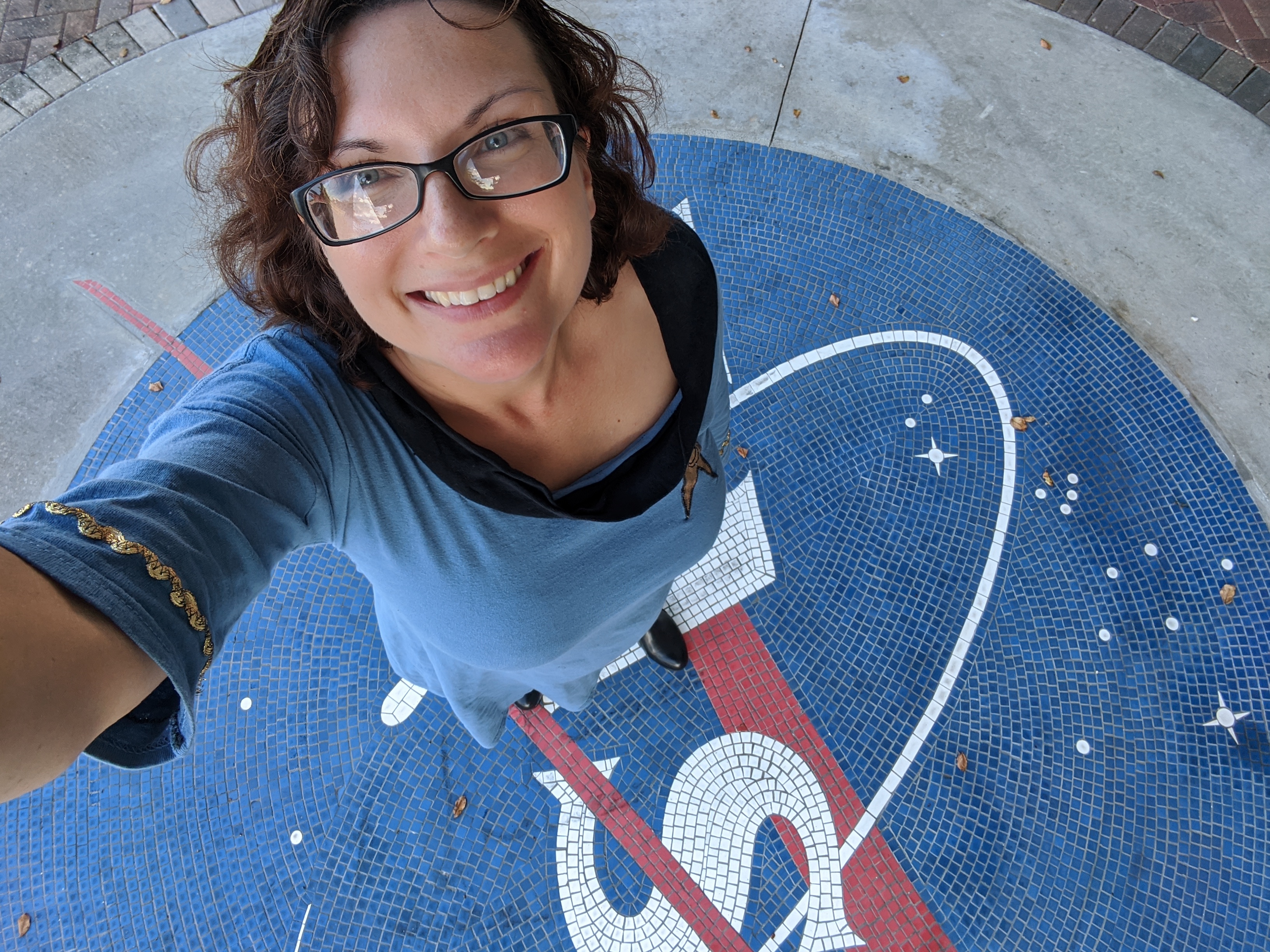
Jim Green:…than 24 hours. Yeah, you know, they ought to do well.
Christina Johnson:For sure.
Jim Green: we don’t have to change their clock or anything, right?
Christina Johnson:Yeah, their circadian rhythm is going to adjust pretty well. We have plenty of plants here on Earth that that do well in environments, where if you think about, in Alaska, there’s months where you have sunshine and months where you have darkness. And there are plenty of plants that can just go dormant, and then come back.
Christina Johnson:So we might have variation like that on Mars where we have like, “Okay, in this area, you get more sun this time of the year and this area, you get less than this time of the year,” and depending on where we’re growing on Mars, we might have different needs.
Jim Green: That’s right, there are seasons on Mars, too.
Christina Johnson:Yeah. (laughs)
Jim Green: Well, you know, every astronaut I talked to that comes back from the International Space Station really loves to go into the module with the plants. And you know, I’ve been calling that the “green effect,” no pun intended.
Christina Johnson:(laughs) Love it. (laughs)
Jim Green: Because, you know, they get to see the beautiful greenery of the plant. But I think there’s more to it. Why do you think this is happening? What really piques their interest in these plants?
Christina Johnson:Well, there’s the connection to the Earth. A lot of astronauts are from agricultural roots. And they’ve grown up with gardens and they’ve grown up with plants and they don’t realize until it’s gone just how much they missed that.
Christina Johnson:Another thing we notice: One of our horticulturists [Jess Bunchek] just recently came back from Antarctica. She overwintered in Antarctica and was taking care of a greenhouse the entire time there and supplementing her crew’s diet with that. There were 10 people who overwintered in Antarctica. And this is called the Eden ISS project and it’s a collaboration with the DLR, which is the German Aerospace Agency. She took care of these plants. It was a separate module from the rest of what they were living in. So, she had to walk in white-out conditions following a rope to this greenhouse where she would walk in, she would get rid of all of her winter clothes, and she would be in this amazing green, lush environment. And she would take care of the plants, and then she would trudge back with a cooler full of delicious produce to share with the rest of her crew, right?
Christina Johnson:And just the fact that she was so isolated and so… [in] such a boring environment all around them. I mean, Antarctica is beautiful, some days, but other days, you just can’t see anything. It’s just white. And she was able to come back and have that fresh fruit to share with people and the crew was like, “Oh, can I go help you in there today?” (laughs)
Jim Green: Well, I think also it’s the smells!
Christina Johnson:Yes, the smells. Oh, another thing. When the world kind of shut down in March of 2020, we had a lot of students interested in growing plants. Jacob Torres, who’s one of the horticulturists here at Kennedy Space Center, he started the Space Chile Grow a Pepper Plant challenge. And he sent seeds to teachers and students, and [it] ended up being a big community outreach effort where they would grow pepper plants in their house, in whatever lighting they had, and I participated in this, I had a little aerogarden that I decided to grow pots of pepper plants in. And I had that, that light, and we had them in our living room for a good, hmmm, six months. And it smelled like peppers in our living room as they were fruiting and flowering. And it was just so fun.
Christina Johnson:But eventually, it got to the point where it was like, “Okay, peppers all the time! Oh, my goodness! When are we going to call this done? (laughs)
Jim Green:(laughs)
Christina Johnson:When are we going to grow something different?” Because we would planted other things and have other things growing like beans, but the peppers would just take over. And that’s another thing to consider when growing things. The peppers were growing in the Advanced Plant Habitat at the International Space Station, which is enclosed. If they were growing in Veggie it would be a very different experience for the crew. Something we found in our house — which maybe doesn’t relate to spaceflight, I don’t know — but with our six pepper plants we had days when there were lots of fruit on those plants. And we’d walk up to that corner of the room and our eyes would start watering and it was just spicy tasting the air.
Jim Green:(laughs)
Christina Johnson:(laughs) I didn’t expect that!
Jim Green:Well, this brings up of course, the question about, you know, what do you think are the type of plants we should be growing on the Moon and then on Mars?
Christina Johnson:I think that on the Moon, it’s a great opportunity for us to test things for Mars later. But it’s also a great opportunity to test things for the Moon. (laughs) Because I do think that we’ll have a sustained human presence on the Moon in the near future.
Christina Johnson:I think that we’re going to need supplemental food, because when we’re on the Moon, we can get regular food delivery from Earth. It’s expensive. It’s hard. But it’s not impossible. When we’re talking about Mars, it’s really hard to get resupply out there. We’re talking years, and by the time the food gets there, it might not be the best quality. Vitamins degrade over time, we’re going to be lacking in vitamin C. That’s one that falls apart within it a year and a half. We’re going to be lacking in Vitamin K, [it’s] one of my favorites because people don’t really know about vitamin K that one’s found in leafy greens and it’s absolutely essential for human life. Yeah, so when we’re talking about the Moon, we’re talking about things to supplement the existing food system. When we’re talking about Mars, we’re talking about more staple crops. Maybe we’re talking about the rice and the potatoes and the sweet potatoes. Sweet potatoes are one of my favorites, because you can eat the leaves, too – the young leaves, which are really tasty.
Jim Green:Well, what are some of those questions that we need to answer in terms of getting the astronauts to grow their own food, say on Mars?
Christina Johnson:So when we’re having our astronauts grow their own food, do we want to have them doing the manual labor? Or do we want to have it automated? How much automation is desirable? And this is actually a trade-off that we see now, with vertical farms and indoor agriculture here on Earth. There’s some companies that have made the conscious choice to have no automation whatsoever, and just rely on their own crew to handle all of the seeding and all of the harvesting, and all of that, because they found that when they added automation, it added the need for additional engineering staff, and they realized they could actually run a leaner business with their people doing everything.
Christina Johnson:But then there’s others [businesses] that grow really big, and the automation is everything, and it’s an economy of scale. So are we feeding astronauts and having this food that we make in space be their sole source of nutrition? When we get to that, we’re going to need that scale. We’re going to need some automation or a lot of automation. When we’re looking at supplementing, maybe we don’t need that automation quite as much. Maybe we could automate seeding and maybe automate harvesting, but the daily care of those plants, the astronauts would still do.
Christina Johnson:Another thing that we want to think about is: How do we help those astronauts? Are we going to choose astronauts who are agronomists and botanists and horticulturists? Or are we going to choose engineers? If we need those astronauts to be dependent on the agronomists here on Earth, the ground crews, then we need to make sure that communication is going to be adequate, and fast enough and good enough. And maybe we’ll want some multispectral or hyperspectral imaging on those plants, like we have on the fields here on Earth. The USDA and NASA worked together to get the satellite imagery for the fields. Maybe we need that on the crops that are in space.
Christina Johnson:And we can we can talk back and forth and say, you know, “these plants are diseased, please cull them now, so that it doesn’t spread.” And maybe we’ll want to say, “Oh, these are dehydrated, there might be a fault in the water delivery system? Please check for that.” Who do we send and do we send both? Do we send the engineers and the plant scientists?
Jim Green: In the last episode, we talked to Dr. Anna-Lisa Paul of the University of Florida where she and her team were able to grow plants called Arabidopsis thaliana in samples of lunar regolith brought back by the Apollo astronauts. Really cool. Christina, you also used this same species in your Ph.D. research, right?
Christina Johnson:So for my PhD, I got out to Miami University, which is a small school in Ohio. And I thought I was just going to be in a lab where other people did a bunch of spaceflight research. And I got to look at the plants that came back. But turns out while I was there, my first semester, I started writing a grant proposal for spaceflight. And turns out, that proposal ended up being useful because there was a call that came out suddenly, for a series of experiments on the Shuttle. They were looking for three investigative teams to run some experiments in the BRIC hardware, which is a closed system with Petri plates that you can grow plants in.
Christina Johnson:And our proposal got picked up, I was very excited about that. And so I got to see from start to finish what it was like to do a spaceflight study. I got to come out to Kennedy Space Center and put my plants, get them into the hardware, get them loaded up in the hardware, say goodbye to them, as they loaded them up onto the shuttle, I got to watch the shuttle launch, I got to watch them come back. Oh, my goodness, a Shuttle landing is such an experience. And then once they came back, within a couple hours, those samples were back in our hands, and I got to take them back to the lab and start looking at them right away. And I was so excited for that experience. I looked at how they grew physically, their morphology, the physical characteristics, and that’s where I noticed, the roots were tilting. That was very interesting. And then we also had the opportunity to do some transcriptomics on those plants as well. And so I got to see what genes were upregulated and downregulated in spaceflight, and the differences there. And then I was able to compare my results with the other three investigative teams that also grew very similar plants at the same time under those same conditions. So that was really a great experience from my PhD.
Jim Green:Well, I can talk to you forever about some of the research that you’re doing and what we also need to do to get ready to live and work on a planetary surface. But unfortunately, we must come to a close. So I always ask my guests to tell me the person, place, or event that gave them so much energy, so much excitement, that they became the scientists they are today. And I call that event a “gravity assist.” So Christina, what was your “gravity assist?”
Christina Johnson:Okay, so I thought a lot about this. And I’m gonna talk about two things. So first, when I was a child, I really liked Star Trek: The Next Generation. It just came out when I was young. And I was very much into the world of make believe. And so I really clung to this one character, Keiko O’Brien, she’s the head of the Conservatory on the Enterprise. And later, she was on Deep Space Nine too. But I thought she was only in a few episodes here and there. But the would interact with Beverly Crusher, the doctor, and she would bring in plants and, and they would have this great exchange of information like, “Oh, this plant would be good for human health.
Christina Johnson: And so in my mind, I built this whole fantasy around O’Brien and I would go on xeno-ethnobotanical expeditions to go collect the best medicines from the most far reaches of the universe, and I would bring them back to my sister who was pretending to be Beverly Crusher. And I would, you know, I would be like, “Oh, look, I can save your patient because I found this!” And she would be like, “Oh, great, yes, let’s use that.” And Keiko O’Brien was definitely my inspiration for thinking about space and plants. But then that was all fantasy. I had no idea that this was a real area of research, until I was an undergraduate at UC Berkeley working in the lab of Dr. Chelsea Specht.
Christina Johnson:And she mentioned I was working on ginger floral development, you know, beautiful things. very applicable to Earth. Ginger is great. I think we should definitely have it on Mars.
Jim Green:(laughs) Okay.
Christina Johnson: She was like, “Christina, you love space!” I’m like, “Yes, I do. I really love space.” She’s like and you love plants. “Did you know you can bring those two together?” And I was like, “Wait, what?” She was like, “I think for your PhD, you should really work with space and plants. And here’s a few researchers who do this.” And so I wrote a blog entry about John Kiss, who does space research, he had plants growing on the European Modular Cultivation System. I just wrote a blog entry about him and his research. He found that blog entry and reached out to me and said, “Come visit our lab. Let’s see if it’s a good fit for graduate school.”
Jim Green:Wow! And I was hooked.
I was like, “You’ve got to be kidding me. I can do space and plants at the same time?”
Jim Green: Your dream came true.
Christina Johnson:Yes. So my gravity assist was Keiko O’Brien fiction. And then reality was Chelsea Specht to who told me “Hey, this is a thing.” And then John Kiss who was like, “Yes, let’s get you. Let’s get you into this area of research.”
Jim Green:Fantastic. Christina, thanks so much for joining me for a fascinating look at how we are planning and do grow plants in space well beyond Earth.
Christina Johnson: Thank you so much.
Jim Green:Join me next time as we continue our journey to look under the hood at NASA and see how we do what we do. I’m Jim Green, and this is your gravity assist.
Credits
Lead producer: Elizabeth Landau
Audio engineer: Manny Cooper















